Mar 2013
Sea lion harassment will be reported to NOAA law enforcement
Mar/31/13 09:11 AM

Fair warning to all recreational boaters, including kayakers:
Any harassment of the sea lions resting on the Elliott Bay buoys is being photographed and sent to NOAA’s Office for Law Enforcement. The Marine Mammal Protection Act (MMPA) prohibits harassment of marine mammals. Stay 100 yards away from any marine mammal resting on shore, buoys, or in the water. It is against Federal Law for boaters to be as close as shown above, taken yesterday afternoon.

A highlight to any day in West Seattle is to get out on the water and enjoy wildlife. If you don’t have a boat or kayak, you can rent one at Alki Kayak Tours. Please comply with the MMPA as you enjoy your boating activities and observe these majestic animals from a respectful distance. This also includes resting seal pups along our shoreline. Resist the temptation to get close. All pinnipeds require time out of the water to rest and regulate their body temperature - it is critical to their health and survival.
If you see a violation and are able to take a photo, try to get a boat license number if at all possible and email photos to us. We will forward to Office for Law Enforcement.
Georgia Gerber selected as sculpture artist for Year of the Seal
Mar/29/13 05:18 PM
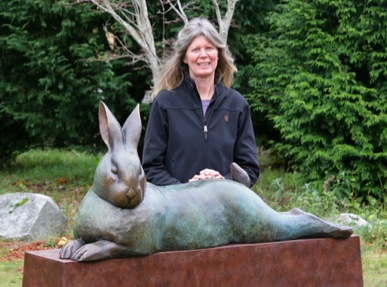
Seal Sitters is excited that an artist of Georgia’s stature will be creating this work. Georgia has many public installations in the Northwest, including the much-loved bronzes Rachel the Pig at Pike’s Market and the Lowland Gorilla Family at Woodland Park Zoo. Many of her singular works show the intimate relationship of two or more animals and evoke an undeniable emotional response from the viewer. Georgia says, “I like my sculpture to invite an interaction with its audience. This is often meant to be a direct physical interaction, but always I strive to engage the viewer's imagination. I tend to present an incomplete visual narrative; a story is suggested, a feeling evoked, and the viewers find themselves providing details." You can view Georgia’s beautiful work here. A community meeting will be scheduled soon to introduce the project and artist to the public. (photo courtesy of the artist)
The bronze sculpture will culminate our educational outreach project, Year of the Seal. The harbor seal is considered by biologists to be an indicator species for the health of our waters. The sculpture will represent all marine life and is intended to raise awareness of our fragile marine ecosystem and serve as a reminder to Share the Shore with wildlife. Click here to learn more about the project (including children’s art and essay contest) and the role harbor seals play as a sentinel species.
A VERY SAD NOTE:
We are terribly saddened to report that Glenn Brewer, a highly respected artist who was one of our selection committee panelists, passed away Wednesday evening. This gentle man was unfailingly generous and positive. It was our privilege to have had his input on this project. Our thoughts go out to Glenn’s family and friends.
Seal pup Ruby finds a much-needed friend
Mar/28/13 11:24 PM
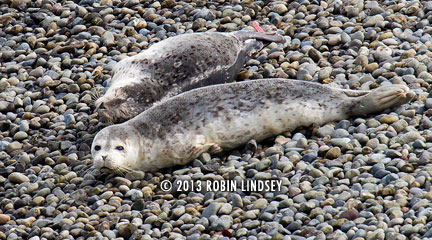
Ruby was taken from a Steilacoom beach to PAWS Wildlife Center when only a week old and had no contact with any other seals while in rehab for several months. Weak and dehydrated, she had been harassed by people on the beach and abandoned by her mother. She was released last October to a harbor seal haulout in that same area, but had not been sighted again until she appeared at a cove near Salty’s in late January.
Volunteers sighted Ruby numerous times over the next weeks on the Jack Block beaches, but never on the abandoned dock with the many other resting seals - she was always alone. That is, until Buddy befriended the 8-month-old pup. Ruby’s health had been taking a turn for the worse, with evidence of respiratory issues and volunteers were monitoring her health from the observation tower above the beach. However, Ruby seems to have rebounded and put on weight since they have been foraging and hauling out together. Buddy is usually on the alert as she sleeps, so she is able to get extended, stress-free rest. It has been a joy to watch this relationship develop as Ruby becomes more open to Buddy’s presence near her. Both volunteers and the public have had a rare opportunity to observe the heartwarming bonding of these two vulnerable weaners - and there truly is safety in numbers for seal pups.
Off leash dog kills sea lion pup - the dangers are REAL
Mar/27/13 06:46 PM
We don’t usually cover out of area stories in Blubberblog - most always they are reported on the Breaking News page of our website. However, this breaking story out of Laguna Beach, CA, drives home our mantra to leash dogs at all times near the beach. A dog on the California beach with the owner, broke free of his leash and grabbed a sick sea lion pup by the throat in front of screaming and crying witnesses, killing the pup. The owner was unable to get the “American Bulldog” to release his grip on the emaciated sea lion. It is apparently legal to take a leashed dog onto that beach. The cellphone video that has been shown on news and internet media is very graphic and, due to the many young readers who visit our blog, we choose not to link to it.
Dogs are not allowed on any Seattle beaches period, leashed or unleashed. That said, we can’t even begin to count the number of times during the year that we have to ask dog owners to please leash their dog and leave the beach. Dogs are a serious threat to a vulnerable seal pup - and other wildlife, including shore birds. This past year, a golden retriever killed a seal pup on Camano Island. It happens all too frequently. Thankfully, to our knowledge, it has not happened in West Seattle - yet; though we had a close call at Lincoln Park last year as a dog chased a pup back to the water, nearly catching him. A month or so later, again at Lincoln Park, an off leash dog attacked one of the resident geese, shaking and dragging the goose out into the Sound. The goose did survive.
The most common reply our volunteers hear at our request is, “My dog would never do anything.” That’s exactly what the owner of a “non-agressive” breed of dog on Bainbridge Island said to a stranding network volunteer a few years ago - minutes before her dog grabbed a resting seal pup, dragged him up into the woods and killed him.
Dogs are unpredictable animals. There is an innate instinct for the chase, which doesn’t bode well for a vulnerable animal or shorebird...or, for that matter, a young child. Too many times after volunteers have talked to dog owners, we’ve seen them struggle to get their dogs back on a leash, under control and off the beach. And, as you can see from the horrifying Laguna Beach story, a highly motivated dog can even break free of a leash. So please help us remind owners to take responsibility and keep dogs leashed at all times - that along with the right to own dogs, comes the obligation to protect other animals and people from them. Even the sweetest of dogs has the potential to do great harm.
Dogs are not allowed on any Seattle beaches period, leashed or unleashed. That said, we can’t even begin to count the number of times during the year that we have to ask dog owners to please leash their dog and leave the beach. Dogs are a serious threat to a vulnerable seal pup - and other wildlife, including shore birds. This past year, a golden retriever killed a seal pup on Camano Island. It happens all too frequently. Thankfully, to our knowledge, it has not happened in West Seattle - yet; though we had a close call at Lincoln Park last year as a dog chased a pup back to the water, nearly catching him. A month or so later, again at Lincoln Park, an off leash dog attacked one of the resident geese, shaking and dragging the goose out into the Sound. The goose did survive.
The most common reply our volunteers hear at our request is, “My dog would never do anything.” That’s exactly what the owner of a “non-agressive” breed of dog on Bainbridge Island said to a stranding network volunteer a few years ago - minutes before her dog grabbed a resting seal pup, dragged him up into the woods and killed him.
Dogs are unpredictable animals. There is an innate instinct for the chase, which doesn’t bode well for a vulnerable animal or shorebird...or, for that matter, a young child. Too many times after volunteers have talked to dog owners, we’ve seen them struggle to get their dogs back on a leash, under control and off the beach. And, as you can see from the horrifying Laguna Beach story, a highly motivated dog can even break free of a leash. So please help us remind owners to take responsibility and keep dogs leashed at all times - that along with the right to own dogs, comes the obligation to protect other animals and people from them. Even the sweetest of dogs has the potential to do great harm.
Scotch on the rocks at Jack Block Park
Mar/23/13 06:37 AM
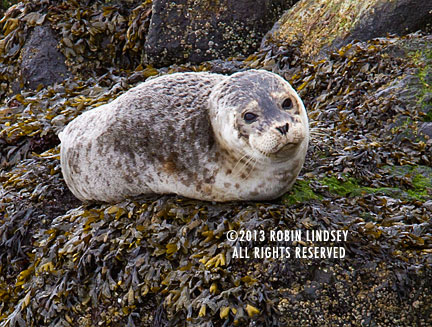
Check out Buzz’s Marine Life of Puget Sound Blog here. It’s an in-depth look at practically everything relating to our marine environment: marine mammals, invertebrates and feeding adaptations of marine animals.
Jack Block Park continues to be a sanctuary for a bevy of seals as we finally move into Spring.
Shamrock and other seal pups lucky to have caring public
Mar/20/13 08:51 AM

A small number of residents of this affluent San Diego neighborhood want the seals removed from the beach so it can become a public swimming beach - they regularly harass the seals. However, the majority of residents appreciate and want to preserve the rookery. Casa Beach is one of only four harbor seal rookeries left on the Southern California coast. There are many, many public beaches along the nearby coast for humans to enjoy, including one within walking distance of Casa Beach. Local wildlife advocates have been fighting for many frustrating years now to get local and federal governments to step up and protect the seals. Finally, it was agreed that a rope barrier would be established on the beach during pupping season, but that has not stopped the abuse.
Recently, a web cam was established on an old lifeguard tower to enable the public to view seals giving birth on the beach; harbor seal pupping season is in full swing in Southern California. The night vision camera recently caught two women beating and sitting on seals, many of them pregnant, and the incident has caused outrage. NOAA has not been yet been able to identify and prosecute the women.
Yesterday, the mayor of San Diego, Bob Filner, ordered the beach and sea wall closed to people at night. However, the public is still allowed down on the beach during the day, with harbor seals just a few feet away giving birth or nursing their young.
Seal Sitters has covered this story since our lead investigator visited the rookery in 2008, returning the following year as well to document moms and their pups. Read our complete coverage of this controversial situation on our website. And, please email Mayor Filner thanking him for closing the beach at night, but encouraging him to close Casa Beach (Children’s Pool) year-round to people and preserve this wildlife treasure. The public has an unparalled view from the sea wall and sidewalk above the beach.
Our West Seattle seal pups are so very lucky to have a stranding network (with a supportive NOAA Northwest office) and public committed to keeping them safe while on our shores. We know that undisturbed rest is critical to harbor seals’ survival and they will be protected under our communal watch.
UPDATE 3/21/13
For the latest news regarding this story, please visit our dedicated website page.
CNN has a feature story on the abuse at Casa Beach on their website today. Click on the link below:
(CNN) SEAL VIDEO BRINGS NATIONAL SPOTLIGHT ON ANIMAL ABUSE
Shamrock doing a jig around West Seattle
Mar/19/13 08:55 PM
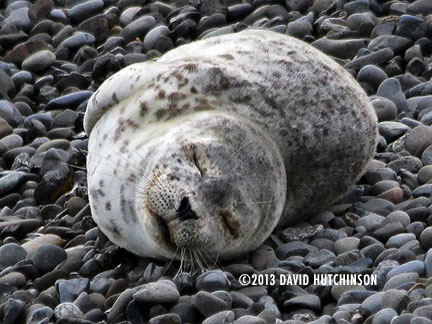
About 2 pm the hotline rang again with another call about a pup that had come ashore at Duwamish Head. The caller kindly kept curious people at bay until our responder could arrive shortly thereafter. Shamrock had moved to the north! Volunteers taped off the beach access and the seawall above her and she snoozed soundly until early evening before swimming off in search of dinner.
This morning, one of our volunteers out walking his dog, noticed a pup on the beach below the sidewalk at Emma Schmitz Viewpoint Park (Me Kwa Mooks). Our first responder was there in minutes, taping off the entrances to the beach stairs so that Shamrock could rest undisturbed. Shamrock is looking too thin, but her activity moving to and from beaches is encouraging - and she is most certainly keeping our first responders and volunteers on their toes! She finally returned to Puget Sound around 5pm this evening.
Please keep your eyes open for this sweet little pup, especially along the beaches of Lowman and Lincoln Park. If you are a waterfront homeowner, please make sure to give our hotline a headsup if you have a pup on your beach tomorrow. We are monitoring Shamrock’s health since she seemed to be thinner today. Thanks to our dedicated volunteers, many of them just trained last weekend, who have protected her the past few days in cold (and often wet) conditions!
St. Paddy's pinniped party in West Seattle
Mar/17/13 10:19 PM
St. Patrick’s Day festivities started early this morning for Seal Sitters’ responder Lynn who was doing a routine check of Jack Block Park beaches. Standing on the observation tower platform shortly after 8am, she noticed rehab pup Ruby, with her bright red flipper tag, haul out onto the inaccessible beach below her. Ruby was only about a week old when she had to be taken to PAWS after repeated harassment by beachcombers in Steilacoom. After a lengthy stay at PAWS to fatten up and learn how to catch fish on her own, she was released back to the wild last October at a harbor seal haulout south of Tacoma. Seal Sitters first sighted her in West Seattle in late January and she has since been a regular visitor along the shoreline of Jack Block. We are excited that she has remained on our beat.
 As Lynn was walking out of the Park, she noticed yet another pup on the public beach, notorious for off leash dogs. She immediately taped off the beach entrance and established a perimeter with sandwich boards and signs. Volunteers were lined up to keep a close eye on the pup, nicknamed Shamrock (shown at right). On this cold and windy day, brand new volunteers (including young volunteers Fionn and Owen) along with more experienced Seal Sitters protected Shamrock until she returned to Elliott Bay late in the day.
As Lynn was walking out of the Park, she noticed yet another pup on the public beach, notorious for off leash dogs. She immediately taped off the beach entrance and established a perimeter with sandwich boards and signs. Volunteers were lined up to keep a close eye on the pup, nicknamed Shamrock (shown at right). On this cold and windy day, brand new volunteers (including young volunteers Fionn and Owen) along with more experienced Seal Sitters protected Shamrock until she returned to Elliott Bay late in the day.
Thanks to the many volunteers who put in such long hours today. Ruby was still resting on the beach as darkness fell, along with a third pup who came ashore near her during the afternoon. It looks like Ruby has found a friend, who has been nicknamed Buddy. A very happy St. Paddy’s indeed!

Thanks to the many volunteers who put in such long hours today. Ruby was still resting on the beach as darkness fell, along with a third pup who came ashore near her during the afternoon. It looks like Ruby has found a friend, who has been nicknamed Buddy. A very happy St. Paddy’s indeed!
Surfin' seal pups are youtube sensation
Mar/13/13 07:33 AM
Late fall of 2011, Ethan Janson of Three Tree Point in Des Moines (Washington) noticed that seal pups were using his windsurf board tethered offshore as a haulout.
One morning before dawn, he attached a remote camera with video capability. Ethan writes Seal Sitters: It took me awhile, but I finally put together a short video of the seal pups on my windsurf board one morning in the fall 2011. It had rained that morning, making the board extra slippery! I mounted the remote GoPro camera to the board before dawn. This footage takes place over a period of about 30 minutes, sometime during the first couple hours after sunrise.
View this fantastic video above. Clips from Ethan’s video aired on both CNN and Good Morning America yesterday - congrats to Ethan for making our Puget Sound surfing seal pups media sensations!
Seeing a number of seal pups struggle to share the small board, Ethan and his neighbor Ron decided to build a platform for seals and contacted Seal Sitters for advice. We put him in touch with wildlife raft guru Guy Smith (who built the first platform south of Alki Beach), who generously offered sage help and detailed instructions. In the spring of 2012, they established an offshore platform at Three Tree Point which is used regularly by seals of all ages.
If you’d like to build a platform for wildlife, please contact us. Since seals spend 50% of their time resting and warming up, platforms provide safe alternatives to beaches crowded with people and dogs.
PUPDATE:
Surfin’ seal pups video has exceeded one and a half million views on YouTube and Ethan appeared on Channel 5’s Evening Magazine last night.
WA House of Representatives bans flame retardants
Mar/08/13 08:47 PM
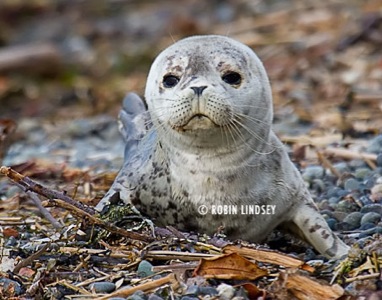
Seal Sitters Marine Mammal Stranding Network and Sno-King Marine Mammal Response strongly support the work of Washington Toxics Coalition and this act. Toxic chemicals in our waterways affect all living things, most especially that of our marine life. A 2005 study showed the harbor seals of South Puget Sound were 7 times more contaminated than those living in Canada's Georgia Strait. Biologists use tissue samples from both live and dead seals to monitor the health of the Sound, measuring levels of PCBs, flame retardants, pesticides and other highly toxic chemicals.
While a ban of PCBs has reduced those toxins in recent years, the number of chemicals used in flame retardants (including those known as PBDEs) have greatly increased. Studies show that PBDE concentrations have been doubling every 3.5 years and have even been detected in the high Arctic. Contaminants are stored in the blubber of marine mammals at the top of the food chain, such as dolphins, seals and orcas. The Southern Resident orcas are among the most contaminated marine mammals in the world. These toxins pass from generation to generation through the milk of mothers to their offspring. Humans, of course, are also at the top of the food chain - and those who consume fish from these toxic waters have high contaminant loads.
Harbor seal pups from our area, the Main Basin of Puget Sound, are more highly contaminated with PCBs and PBDEs than other areas of Puget Sound. Sadly, because seal pups are so contaminated, they are considered the ideal subject for these studies. Read the full study of contaminants in Puget Sound here.
Exposure to flame retardants causes physical abnormalities (including that of the brain, impairing the development of motor activities and cognition), behavioral changes, impairs reproduction and causes immune disorders.
The passage of the Toxic-Free Kids and Families Act HB 1294 is a major step forward in reducing the devastating impact of flame retardants in our waters. Congratulations to Washington Toxics Coalition and their partners for this major achievement. Read more about their important work and environmental toxins here. The bill must now go before the State Senate. Please contact your senators here to let them know you support this act! Ensure that Washington State is the first in the nation to ban these flame retardants.
Read more about our polluted waters on Seal Sitters’ website. Seal Sitters’ Year of the Seal educational outreach project will focus on the health of our marine ecosystem and the harbor seal as the sentinel species representing the marine life of Puget Sound.
Call to Artists for Year of the Seal sculpture project
Mar/07/13 11:12 AM
Seal Sitters has formally released a Call to Artists (Request for Qualifications) for our Year of the Seal sculpture of a harbor seal mom and pup which will be located on Alki Beach. The installation site near the Aki Bathhouse has been approved by Seattle Department of Parks and Recreation. A public meeting will be scheduled to receive input from the community.
Call to Artists (Request for Qualifications)
If you are an artist who works in bronze and have a proven track record of public art installations, please download the application here. The deadline for entry is March 22, 2013 and chosen artist will be notified March 26th. Target installation date is the end of August with Harbor Seal Day celebration and dedication on September 7th.
The winners of the children's essay and art contest will be featured on Seal Sitters' website and blog (and other media) and will be recognized at the celebration event.
The Department of Neighborhoods grant project will serve to remind us that ours is a fragile ecosystem. It will raise community consciousness about the importance of protecting our marine environment - and that of all marine life, including shorebirds, that call Puget Sound home. It will provide a unique educational message that our urban shores are home to many other species - and a reminder to “Share the Shore” with wildlife. Learn more about the Year of the Seal educational outreach project here.
Call to Artists (Request for Qualifications)
If you are an artist who works in bronze and have a proven track record of public art installations, please download the application here. The deadline for entry is March 22, 2013 and chosen artist will be notified March 26th. Target installation date is the end of August with Harbor Seal Day celebration and dedication on September 7th.
The winners of the children's essay and art contest will be featured on Seal Sitters' website and blog (and other media) and will be recognized at the celebration event.
The Department of Neighborhoods grant project will serve to remind us that ours is a fragile ecosystem. It will raise community consciousness about the importance of protecting our marine environment - and that of all marine life, including shorebirds, that call Puget Sound home. It will provide a unique educational message that our urban shores are home to many other species - and a reminder to “Share the Shore” with wildlife. Learn more about the Year of the Seal educational outreach project here.
No spring break for Seal Sitters volunteers
Mar/07/13 06:51 AM
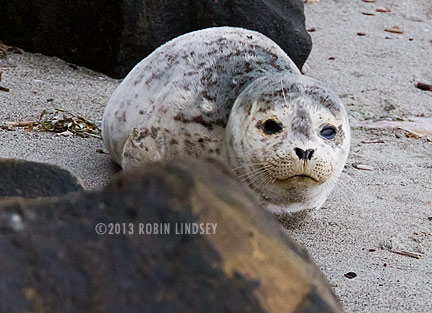
Finally, she was able to get an id photo of this elusive pup who seems to be coming ashore at night, leaving early morning. We’ve known a pup was using this hideaway because we have often seen tracks leading back down to the water’s edge. Sometimes, we’ll get a quick glimpse of the pup just as daylight starts to creep over the horizon and he flops across the sand into the Sound. We wondered if it could be Spencer (whom we have not seen since mid-February), but id photos have shown this is indeed a new pup.
This is one stealthy little seal who is getting some much-needed rest in the quiet of night. Nicknamed Sneaky Pete, we hope the pup continues to find safe haven on our shore during times when the beach is void of people and off-leash dogs. If you come across Sneaky Pete (or any other pup or marine mammal), please call our hotline at 206-905-7325 (SEAL).
Seal Sitters enjoy Latte on the beach
Mar/04/13 07:40 PM
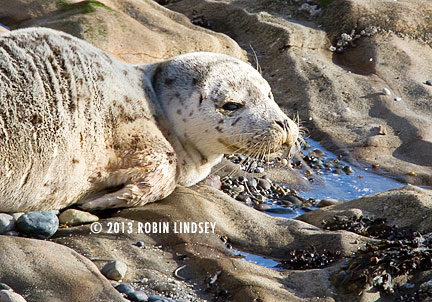
The small pup with a cream colored coat was nicknamed Latte. Volunteers watched over the 6 - 8 month old seal, who snoozed contentedly in the warm sun on this gorgeous day. Latte began to stir late in the afternoon as passersby lingered and chatted a bit too loud above him. Volunteers try to gently urge folks to move along and observe further away from pups, but people get excited and want to get as close as possible. Seawalls and sidewalks pose difficult challenges for maintaining a safe and quiet buffer zone for a resting pup.
Like many other weaned pups, Latte was definitely too thin and has some respiratory issues. As he awoke, he turned to face a terribly wide stretch of rocky beach at low tide, separating him from the water. We assumed he would wait for the high tide late tonight rather than make the long, difficult crawl - approximately 100 yards. However, Latte surprised and delighted us all by making the journey (and at a rather impressive pace) back to the cobalt blue waters of Puget Sound shortly before 4pm.
As seems to be the norm, there were way too many dogs illegally on the beach today. While most were leashed, a number were not - putting Latte at risk for injury. We are thankful, however, that all dog owners were cooperative and quickly left the beach when informed there was a seal pup.
Thanks to all our volunteers for looking after skinny Latte today and giving him (or her) the rest critical for survival. Long after Latte returned to the water for dinner, a few of us lingered - soaking in the warmth of the sun as it sank slowly in the sky and the drop-dead view of the snow-capped Olympics. This was just about a perfect day - protecting a struggling pup, who showed the strength and will to inspire us all, and sharing the strong bond of friendship that we have all formed while doing so.







